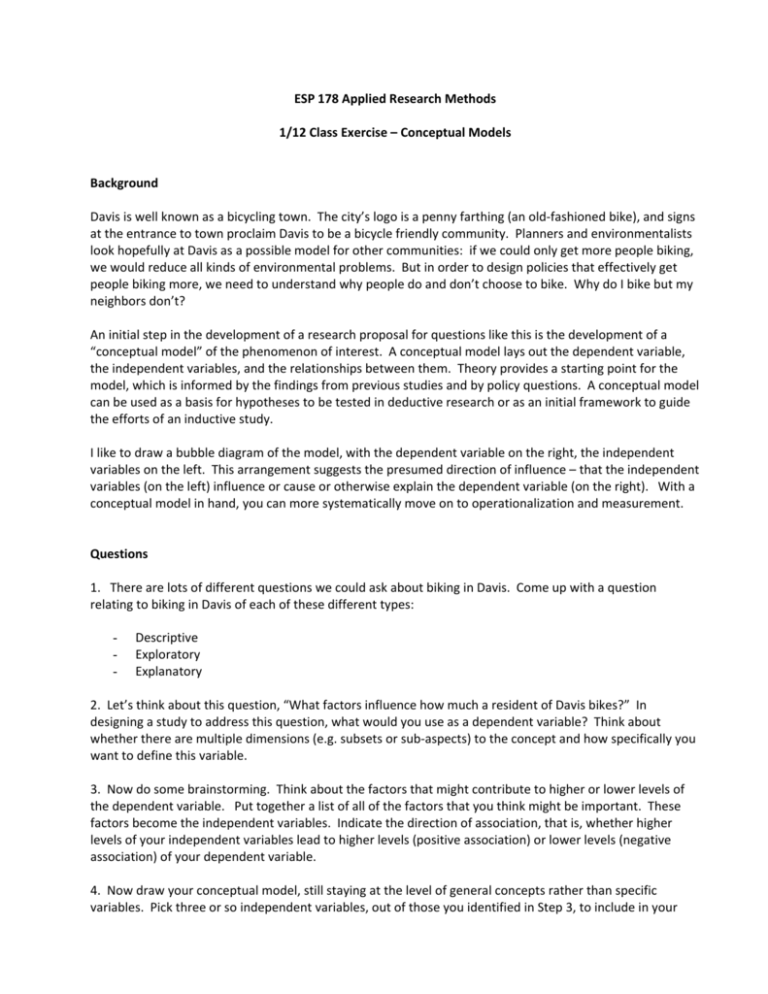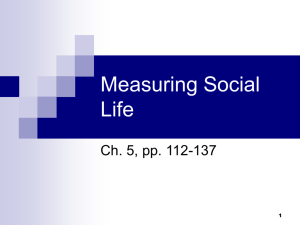Exercise - Environmental Science & Policy
advertisement

ESP 178 Applied Research Methods 1/12 Class Exercise – Conceptual Models Background Davis is well known as a bicycling town. The city’s logo is a penny farthing (an old-fashioned bike), and signs at the entrance to town proclaim Davis to be a bicycle friendly community. Planners and environmentalists look hopefully at Davis as a possible model for other communities: if we could only get more people biking, we would reduce all kinds of environmental problems. But in order to design policies that effectively get people biking more, we need to understand why people do and don’t choose to bike. Why do I bike but my neighbors don’t? An initial step in the development of a research proposal for questions like this is the development of a “conceptual model” of the phenomenon of interest. A conceptual model lays out the dependent variable, the independent variables, and the relationships between them. Theory provides a starting point for the model, which is informed by the findings from previous studies and by policy questions. A conceptual model can be used as a basis for hypotheses to be tested in deductive research or as an initial framework to guide the efforts of an inductive study. I like to draw a bubble diagram of the model, with the dependent variable on the right, the independent variables on the left. This arrangement suggests the presumed direction of influence – that the independent variables (on the left) influence or cause or otherwise explain the dependent variable (on the right). With a conceptual model in hand, you can more systematically move on to operationalization and measurement. Questions 1. There are lots of different questions we could ask about biking in Davis. Come up with a question relating to biking in Davis of each of these different types: - Descriptive Exploratory Explanatory 2. Let’s think about this question, “What factors influence how much a resident of Davis bikes?” In designing a study to address this question, what would you use as a dependent variable? Think about whether there are multiple dimensions (e.g. subsets or sub-aspects) to the concept and how specifically you want to define this variable. 3. Now do some brainstorming. Think about the factors that might contribute to higher or lower levels of the dependent variable. Put together a list of all of the factors that you think might be important. These factors become the independent variables. Indicate the direction of association, that is, whether higher levels of your independent variables lead to higher levels (positive association) or lower levels (negative association) of your dependent variable. 4. Now draw your conceptual model, still staying at the level of general concepts rather than specific variables. Pick three or so independent variables, out of those you identified in Step 3, to include in your model. Focus on variables you think are most important in explaining the dependent variable. Be sure to include one independent variable that can be influenced by policy. Include at least one mediating variable. Can you come up with a moderating variable? 5. Based on your conceptual model, you should be able to state a clear, testable hypothesis. An easy way to think about this is to fill in the blanks: If X is higher, Y is higher/lower. In the hypothesis, X is one of your independent variables and Y is your dependent variable. Pick one of the independent variables you think would be especially interesting to study. Don’t forget to turn in your group summary! For the next class: 6. Once you’ve got a hypothesis, you can think about operationalization – moving from general concepts to more specific variables to ways of measuring those variables. Start with your dependent variable. - - How do you want to define the variable? How could you measure this variable? A survey, observations…? What level of measurement would you use? o What is a nominal version of the variable? o What is an ordinal version of the variable? o What is a ratio version of the variable? Does your measure meet the criteria for face validity? For content validity? What could you compare your measure to as a test of criterion validity – what’s the “gold standard”? How would you test the reliability of your measure? 7. If you’ve got time, repeat step 6 for one of your independent variables.








